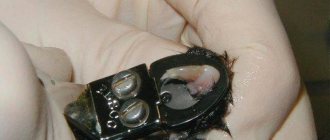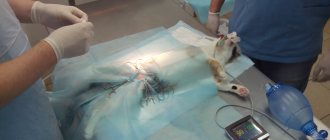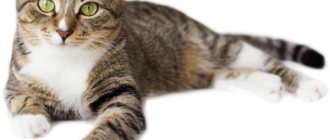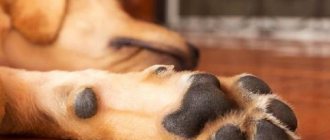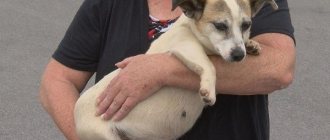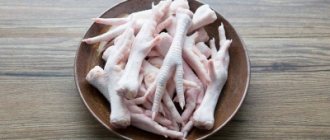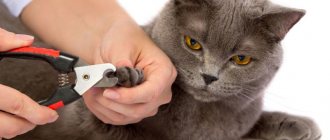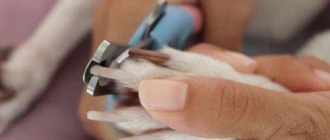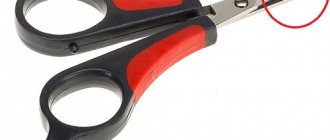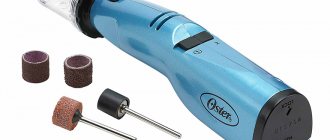“Soft paws” or onychectomy is an operation to remove claws from domestic cats. It is considered a drastic solution in cases where the pet constantly damages furniture and household items or exhibits aggressive behavior. But is this procedure as safe as some veterinarians say it is, and what consequences can it have for your pet?
General information
Onychectomy is not just “cutting the cat’s claws forever”, it is more like amputating the phalanges of the paws.
There are several options for performing the operation:
- Surgical declawing of a cat using a scalpel and scissors under general or local anesthesia.
- Modern method of declawing using laser.
- Separation of connections between tendons and claws. As a result, the cat’s claws will not grow, or, on the contrary, they will grow too quickly, which happens extremely rarely.
Upon completion of the operation, the animal is injected with painkillers and sent home.
TIP: The best age at which the paws will heal as quickly as possible is considered to be up to 1 year, but not less than 8-9 months. At a younger age, they are not yet fully formed, but after that, the nails are already harder.
Features of the rehabilitation period
In order for healing to proceed quickly and without problems, after the intervention you must follow medical recommendations:
- regularly treat the surgical wound and change dressings;
- minimize the load on the injured area;
- exclude thermal procedures (hot bath, saunas, steam baths);
- Do not visit the pool or bodies of water.
To make an appointment with GMS Hospital specialists and remove a foreign object, please call or fill out the feedback form on the website.
Advantages and disadvantages of declawing cats
It doesn't take long to remove a cat's claws. But are there any advantages from this? Yes, I have. This is the impossibility of damaging furniture and the absence of scratches on the skin of household members.
But the disadvantages include a number of points:
- anesthesia is not just a dream, but stress for the body;
- the animal is in great pain for a very long time after the operation. The pain is dulled with various painkillers, which is also considered an intervention in the body;
- the phalanx may grow back and require repeated surgery;
- This is real stress for a cat, which not every animal experiences without consequences.
- a cat without claws is defenseless, and any trip outside can end in disaster;
- as a result of onychectomy and a feeling of vulnerability, the pet may use its teeth;
- the pet’s character changes, it may become withdrawn;
- Difficulties with the toilet: sometimes cats refuse to go to the litter box due to the inability to rake;
- the animal will never step on the entire foot completely again in its life, which affects its gait.
Therefore, maybe it’s worth thinking about other options for protecting furniture from cat scratches?
Purpose of Cat Declawing Procedure
In most cases, owners decide to remove cat claws because the animal begins to damage interior items. Agree, not everyone can accept the loss of their favorite leather sofa, beautiful wallpaper and other expensive things.
Another reason, and it is more significant, may be aggression towards other animals, children and household members. But is it worth resorting to such radical methods of solving the problem? You need to start from the very basics. You should first try to raise your cat using primitive methods. For example, punish for damaged property, using various ways to show that such behavior is unacceptable.
If you couldn’t come to an agreement with your cat, then you should try to purchase special care items, such as a scratching post. Don’t forget that scratching posts are also different and before you give up, you should try several of their options, because not every one may suit your furry beauty’s taste.
Among other things, it is better to accustom your animal to trimming its nails from a very young age. This manipulation should be carried out approximately every 3-4 weeks, this can also protect your property from damage.
If none of the above methods helped you, then you can use a device called “anti-scratch.” These are caps that are put on the claws and attached with special glue. They do not last forever and require periodic replacement as needed.
Preparation, diagnostics
To safely and accurately remove foreign objects from soft tissue, you need to determine its location as accurately as possible. For this purpose, the following techniques are used:
- radiography (in the presence of radiopaque bodies, for example, metal);
- transillumination – in the presence of glass, plastic objects, wood, etc.;
- Ultrasound of soft tissues.
If the intervention involves tissue incision, preoperative preparation includes a set of blood tests (biochemistry, general, sugar, coagulability, group and Rh factor, hospital infections). In situations where part of the foreign object is located above the surface of the skin and can be easily removed without resorting to incisions, no preparation is required.
What is soft paw surgery?
Onychectomy is a surgical procedure to remove a pet's claws. Popularly, the procedure has the pleasant name “soft paws”, but in fact it is a serious test for the cat. During the manipulation, the veterinarian removes not only the transparent plate with a sharp end, but also the entire claw phalanx (part of the finger). The operation is performed in a clinic under general anesthesia.
Any surgical intervention in one way or another affects the physical and psychological state of the animal. Unlike most surgical procedures, the soft paw procedure is often performed only at the whim of the owner and is not aimed at saving the life and health of the animal.
Pet owners can choose more humane ways to deal with the problem of sharp nails. Among them:
Cat claw covers
- painless trimming of nails twice a month using a special nail clipper;
- purchasing silicone stickers;
- buying a scratching post.
Indications for surgery
There are no absolute indications for “velvet paws” surgery. An owner who agrees to get rid of his pet’s sharp claws once and for all must understand the seriousness and danger of this procedure.
Relative indications for surgical intervention of this kind can be considered:
- exceptionally aggressive nature of a pet that cannot be trained;
- unsuccessful attempts to train an adult pet to sharpen its claws in a specially designated area;
- regular attacks on small children living in the same house with a cat;
- fungal disease of the claw plate in an advanced stage, which is difficult to treat;
- seizures of epilepsy (claws are removed so that during an attack the animal does not injure itself or a person);
- abnormal ingrowth of claws into the fingertips, deformation of the claw phalanx.
Contraindications to amputation of claws
It is strictly forbidden to perform the “velvet paws” operation on cats leading an outdoor lifestyle. Without claws, the animal becomes defenseless and will not be able to climb a tree or protect itself from attacks by stray dogs.
It is highly undesirable to perform onychectomy on cats living on the upper floors. It is known that they love to walk on the balcony and hunt for birds. Without claws, a cat is defenseless; it will not be able to catch on to the railing when falling from a height.
Also, any surgical interventions are contraindicated in cats who are allergic to anesthesia. The consequences of an allergic reaction can be serious, including death.
How is the operation soft paws for cats performed?
If you have made a conscious decision to have a soft paw surgical procedure, it is important to find a good veterinarian who will competently and skillfully perform this operation. It is usually performed under general anesthesia. No one “rips out” the claws, the doctor carefully removes them using special tools, the pillows are not injured, sutures are placed on the incisions, it is better if they are absorbable. The paws are bandaged to protect them from bleeding. Additional medications may be prescribed to help the cat recover better from anesthesia.
Description of declawing surgery
Onychectomy is banned in a number of European countries.
Local anesthesia is sometimes used for the operation, but general anesthesia is more often used.
The claws are removed entirely from the first phalanx of the finger. A suture and anesthetic ointment are applied to the damaged area. Then the paw is bandaged, and a collar is put on the cat’s neck, which will protect the seams from licking.
Along with the application of anesthetic ointment, auxiliary injections are administered.
Post-operative cat care
Usually after 6-10 hours the cat can already move independently. It is recommended to keep an eye on her for at least a day or two until she completely recovers from anesthesia; this time is individual for each animal. Veterinarians recommend providing the animal with a comfortable bed on the floor, limiting walking and jumping in the first hours after surgery, and not allowing jumping from a height.
A day or two after the operation, the paws may bleed, and the cat will feel uncomfortable stepping on them, but within 10-12 days everything should return to normal, and the cat will continue to run, play and jump on cabinets.
Benefits of visiting GMS Hospital
Removal of foreign objects from soft tissues at the GMS Hospital surgical center does not take much time and is performed on an outpatient basis, using local anesthesia and modern surgical equipment. By contacting us, each patient receives:
- fast, qualified surgical care without queues or delays;
- treatment of wounds and injuries of various types;
- non-hazardous and painless removal of a foreign object of any nature;
- in the presence of a serious traumatic injury, hospitalization is possible;
- the surgery center is equipped with the necessary equipment for rapid diagnosis and surgical treatment of foreign bodies in soft tissues;
- The operation is performed within an hour after treatment on an outpatient basis.
The center’s specialists have extensive experience in performing such interventions and quickly remove an object of any nature, using modern equipment and safe anesthesia. To make an appointment, please call the reception desk or leave a request on the website.
Rehabilitation of cats after onychectomy
When the cat's claws are removed, the process of recovery after surgery begins, both for the condition of the paws and for the entire body. Fluffy needs the caring attitude of the owner.
There are a number of nuances for caring for a cat:
- pain relief in the form of injections, if necessary;
- daily treatment of wounds;
- the dressing needs to be changed regularly;
- A visit to the doctor is recommended once a week.
The cat is really looking forward to its owner's love and care, only in this case it will get better sooner.
The recovery period after surgery lasts a month. During the first few days it is painful for the cat to stand on its paws; it will be hampered by pain and discomfort. Then the walking process gradually improves, but the cat may limp.
It is better to remove the cat's claws first on the front paws and then on the back paws. One by one deletion is allowed. This requires expert advice.
Possible complications
There are many negative effects after an operation called “soft paws”. The experience and professionalism of the veterinarian plays a big role - violation of the surgical technology entails a risk of infection. Also, if the soft tissues do not heal properly, the cat may experience discomfort when walking, resulting in changes in the animal’s gait and posture.
Cost of services
The prices indicated in the price list may differ from the actual prices. Please check the current cost by calling +7 495 104 8605 (24 hours a day) or at the GMS Hospital clinic at the address: Moscow, st. Kalanchevskaya, 45.
| Name | Price |
| Removal of a foreign body from the ear, nose, throat | RUB 8,075 |
| Removal of a foreign body with tissue dissection | RUB 11,680 |
| Consultation with surgeon Alexander Givievich Natroshvili | RUB 4,999 |
Dear Clients! Each case is individual and the final cost of your treatment can only be found out after an in-person visit to a GMS Hospital doctor. Prices for the most popular services are indicated with a 30% discount, which is valid when paying in cash or by credit card. You can be served under a VHI policy, pay separately for each visit, sign an agreement for an annual medical program, or make a deposit and receive services at a discount. On weekends and holidays, the clinic reserves the right to charge additional payments according to the current price list. Services are provided on the basis of a concluded contract.
Plastic cards MasterCard, VISA, Maestro, MIR are accepted for payment. Contactless payment with Apple Pay, Google Pay and Android Pay cards is also available.
Western standards of treatment (evidence-based medicine)
Continuous staff development
Regular interaction with leading Russian and foreign medical institutions
Modern medical equipment and advanced diagnostic and treatment methods
Unified standard of service
We work around the clock 24/7/365
Make an appointment We will be happy to answer any questions Coordinator Oksana
Consequences of declawing a cat
The results are the most disappointing. Interfering with the structural integrity of a cat’s body, in fact, makes the cat disabled.
In this case, the torment begins the moment the patient wakes up from anesthesia. The poor things are not feeling well. Requires careful care. Nausea and vomiting, increased body temperature and rapid heartbeat are observed. If you are allergic to the components of anesthesia, the outcome can be fatal.
The recovery period lasts at least a month and is complicated by severe pain.
Wounds require daily thorough treatment (washing, applying healing agents, changing the bandage). To avoid tearing off the bandages and injuring the paws, a protective collar is put on the patient, which causes a lot of inconvenience to the already unfortunate creature.
Regardless of the type of anesthesia, the animal experiences severe pain after surgery.
The first days after the operation the animal refuses to eat and does not move. After 5-8 days he takes his first steps, causing physical suffering. The vestibular apparatus undergoes dramatic changes, including when distributing the load. Purr is learning to walk again.
More about the procedure
Domestic or industrial injuries often lead to penetration of various bodies into soft tissues (skin, subcutaneous tissue, muscles) - glass and wood fragments, needle fragments and metal particles, plant thorns, etc. Small objects, for example, a wooden splinter located in the superficial layers of the skin, can often be removed independently. However, in order to avoid even greater tissue injury and the development of inflammation and suppuration, such manipulations are best carried out in a medical institution. Removal of foreign objects from soft tissues at the GMS surgery center is performed quickly, painlessly and with minimal trauma.
Consequences and complications
Let's look at the complications caused by merciless surgery:
- pathologies of the musculoskeletal system (impaired coordination of movement, falling on paws, changes in gait);
- joint damage (arthritis) caused by load changes;
- purulent infections of bone tissue (osteomyelitis);
- curvature of the spine caused by newly acquired defects (the operated pet steps on the entire foot when walking and running, a healthy individual only on the toes);
- muscle atrophy.
At the same time, the following disease processes are observed:
- bleeding from the wound surface;
- decreased resistance to diseases;
- deformation of nerve endings, in which every step, even after external wound healing, causes pain;
- development of urolithiasis;
- ingrown claw (the stratum corneum remaining after poor-quality treatment grows inward, causing inflammation);
- blood poisoning;
- injuries received by a crippled creature as a result of loss of its former balance;
- dysbiosis and other changes in the digestive organs caused by the consumption of antibiotics necessary for the speedy healing of wounds.
At the same time, onychectomy traumatizes the psyche.
Declawing causes damage to a large number of nerve endings
The pet becomes fearful, aggressive and withdrawn. Instead of claws, she uses her teeth, including without reason (when a person tries to approach her).
Some specimens stop relieving themselves on the tray because they cannot rake up the litter in order to bury excrement. Social life becomes more complicated. Warriors become vulnerable on the street. They may die from the teeth of relatives or dogs.
Relationships with the opposite sex worsen. Love games lose their charm due to the impossibility of giving a slap in the face, which is characteristic of this process.
Amputation leaves an indelible mark on a kitten. Experienced fear, pain and inconvenience make the baby angry, unsociable and antisocial.
Unfortunately, there are currently many supporters of cruel surgery. It seems to them that the procedure will not harm their beloved kitty.
Since ancient times, pulling out people's nails has been equated to torture. This is worth thinking about!
Indications for surgery
You need professional help when inserting any object into soft tissue due to injury. Do not delay your visit to the surgeon if the following situations occur:
- inability to independently remove a foreign object;
- development of bleeding due to damage to the vessel by a foreign body;
- when palpating the location of a foreign object, severe pain is felt;
- infiltration, inflammation or suppuration has occurred in the area where the object was introduced;
- the wound does not heal, a purulent fistula has formed;
- loss of sensitivity is noted at the location of the foreign object.
There is no need to endure pain and delay treatment. All this can end in wound suppuration and general blood poisoning. To avoid complications and quickly forget about the incident, promptly contact a surgeon who will quickly and painlessly carry out all the necessary manipulations.
Alternative to Declawing
There are options in which the risk to your pet’s health is minimized.
Trimming
Murka is fixed so as not to damage the limbs. If necessary, bring in an assistant. Using forceps with rounded ends, carefully cut off the overgrown stratum corneum (no more than one millimeter). The use of scissors is not recommended. Manipulations are fraught with cuts. The structure of the plate is damaged.
Using special stickers
The best way. Non-toxic glue developed by veterinarians is applied to the claws, onto which silicone stickers of the appropriate shape are fixed. Harmless, available in different colors.
The stickers are effective for a month. Good for long-term use.
Gluing silicone caps to the cat's claws
Alternative to surgery
There is a way to solve the problem peacefully. These are practical silicone pads that are attached to the phalanges using hypoallergenic glue. Anti-scratch guards are available in different colors and sizes, so that the claws of both a kitten and an adult animal can be neutralized.
The only drawback is the need to change the anti-scratch pads every month for hygiene purposes. We recommend that you contact your veterinarian to perform this procedure. The doctor of the Kaliningrad Regional Center of Veterinary Medicine will select the optimal size pads and glue them to the phalanges with minimal stress for the pet. Result: the sharpness of claws will become a thing of the past along with damage to wallpaper and furniture. In this case, the goal will be achieved without injuring the cat through surgery.
To avoid waiting in line at the veterinarian, we recommend making an appointment in advance at the branch that is closest to you. Contact numbers are listed in the “Contacts” section.
